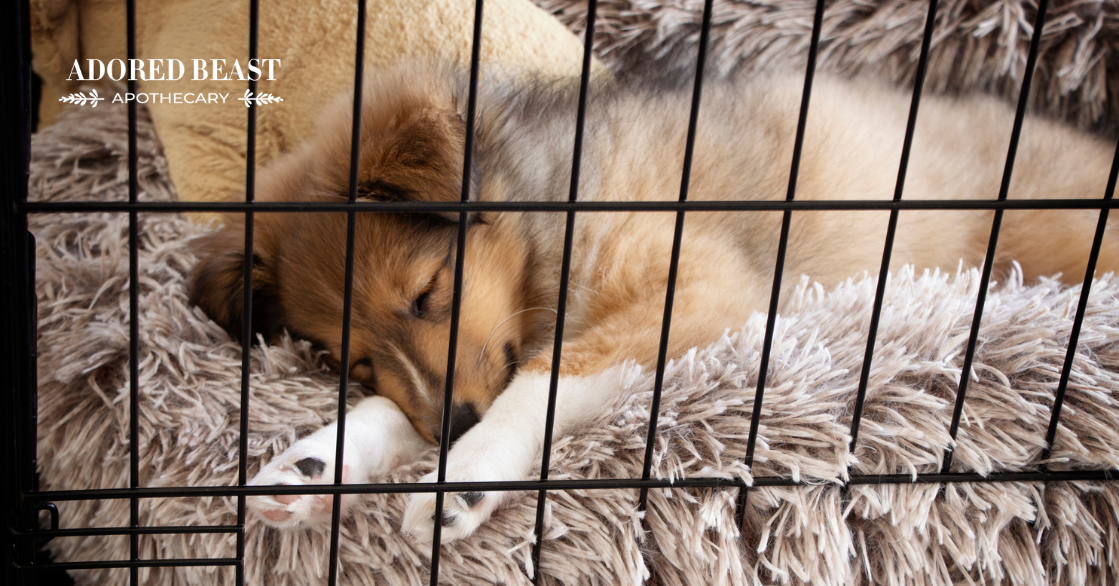Many moons ago, when our late pup Inuk was a puppy, we lived with my mom. We planned to crate train her, for the many reasons I’ll get into later. And so we’d put her in the crate before bed, give her a treat, and we’d go to bed. She’d cry a little bit, then stop and sleep soundly all night, crying in the morning when it was time to get up. We thought all was going so well.
That was, until a few weeks into the routine, we woke up early to find her in bed with my mom! From day one, my mom had been sneaking in and taking her out of the crate because she couldn’t bear to hear her whimper. Then she’d sneak her back in in the morning before we got up (that’s what the morning crying was). What a softy! After that, Inuk learned that crying was a sure-fire way to get out of the crate, and all hope was lost… (not really, we worked on it, but it was much harder).
Thankfully, with Indi, we were in our own home, and there was no grandma to save her from the perils of the crate. She crate trained like a dream, and though she didn’t (and still doesn’t) use it often, it’s a handy skill to have.
Crate training a puppy is something that many dog parents do to help their puppies adjust to their new homes and develop good habits. Whether you plan to use a crate regularly or not, understanding the benefits of crate training and how to do it correctly can be beneficial for both you and your puppy.
The Benefits of Crate Training
We know that the idea of crate training can be a point of contention among pet parents. Some argue that confining a dog to a small space can be cruel, especially if the crate is used as a form of punishment or if the dog is left in the crate for extended periods.
And we agree that the crate should not become a punishment, or that dogs should be kept in the crate for hours on end, day after day.
But when done correctly, crate training is not about confinement – it’s about creating a safe and comfortable space for your puppy. It’s important to remember that dogs are naturally den animals. In the wild, they seek out small, enclosed spaces for safety and comfort. A crate can mimic this environment if introduced and used properly.
There are many reasons why having your puppy get used to a crate early on is a very good idea. Crate training a puppy offers several advantages that can make life easier for both you and your puppy:
- Safety and Security – A crate provides a safe and secure space for your puppy, especially when you can’t supervise them. It can prevent them from getting into dangerous situations, like chewing on electrical cords or ingesting harmful objects.
- Reducing Anxiety – Many puppies find comfort in the den-like environment of a crate. It can become their sanctuary where they feel safe and relaxed, especially during stressful situations like thunderstorms or when guests visit.
- Travel Safety – Whether you’re going on a long road trip or just a short drive to the vet, a crate can help keep your puppy secure in the car. This not only keeps them safe but also reduces distractions for the driver.
- Veterinary and Boarding Visits – If your puppy is comfortable in a crate, they will likely experience less stress during visits to the vet or when they need to be boarded. Crate training can make these necessary experiences less traumatic for your dog.
- Recovery from Illness or Surgery – If your dog needs to recover from surgery or an illness, a crate can provide a safe space where they can rest without risk of injury.
- Emergency Situations – In an emergency, such as a natural disaster or an evacuation, you may need to confine your dog to a crate for their safety. If your puppy is already crate trained, they will handle the situation with less stress.
Ok, so how do you do it?
Tips for Successful Crate Training
Crate training should be a positive experience for your puppy. Here are some tips to help make the process smooth and stress-free:
- Choose the Right Crate
- The crate should be large enough for your puppy to stand up, turn around, and lie down comfortably, but not so large that they can use one end as a bathroom. Many crates come with dividers, allowing you to adjust the size as your puppy grows.
- Make the Crate Inviting
- Line the crate with a soft blanket or bed to make it comfortable. Place some of your puppy’s favourite toys inside to encourage them to explore the crate. You can also toss in some treats to create positive associations. But, especially if your puppy is a chewer, don’t leave those toys in there if your puppy is going to be left unsupervised.
- Don’t Forget the Water
- You want to make sure your puppy always has fresh water if they’re in the crate for more than an hour. You can find bowls that will attach to the inside of the crate to avoid spillage.
- Introduce the Crate Gradually
- Start by leaving the crate door open and allowing your puppy to explore it on their own. Praise and reward them when they go inside. Gradually increase the time they spend in the crate, always making it a positive experience.
- Location, Location, Location
- Your puppy will want to be where you are, so especially in the early days, move the crate around to wherever you are in the home. If you’re working on it while watching tv, keep it in the living room. Making dinner? Move it into the kitchen. At night, move it to the bedroom.
- Feed Meals in the Crate
- Feeding your puppy their meals in the crate can create a positive association with the space. Start by placing the food bowl just inside the crate, then gradually move it further back as your puppy becomes more comfortable.
- Avoid Using the Crate as Punishment
- Never use the crate as a punishment. The goal is for your puppy to see the crate as a safe, positive place. If they associate the crate with punishment, they will resist going inside and may develop anxiety.
- Start with Short Periods
- Begin by crating your puppy for short periods while you are home. Gradually increase the time as they become more comfortable. Always make sure to take them out to relieve themselves before crating them for extended periods.
- Be Patient and Consistent
- Crate training takes time and patience. Stay consistent with your approach, and don’t rush the process. Every puppy is different, so it’s important to go at your puppy’s pace.
- Nighttime Crate Training
- If you plan to crate your puppy at night, place the crate in your bedroom so they don’t feel isolated. This can help them settle more easily and reduce nighttime whining. When we crate trained Indi, we kept her crate beside the bed so she could see us at night. The first few nights I slept on the floor with my hand in the crate ❤️
Making Your Puppy Comfortable
Here are some additional strategies to help your puppy feel at ease in their crate:
- Cover the Crate: Placing a blanket over the crate can create a cozy, den-like atmosphere that many puppies find comforting. Just make sure there is adequate ventilation.
- Use Calming Aids: Consider using calming aids, such as pheromone sprays or diffusers, to help reduce anxiety. Some puppies respond well to soothing music or white noise as well.
- Create a Routine: Establish a consistent routine for crating your puppy. Dogs thrive on routine, and knowing when it’s crate time can help reduce anxiety.
- Exercise Before: Once your puppy is comfortable with the crate, and you’re ready to leave the house, have a good play outside or go for a nice walk beforehand. They’ll be less inclined to put up a fuss if they’re sleepy.
How long will it take? That depends on your pup. Some take no time at all, while others may take more time and patience. But don’t give up! With a little perseverance, your pup will be set up for whenever the crate is needed!
Crate training can be a valuable tool for managing your puppy’s safety, behaviour, and well-being. Whether you plan to use a crate regularly or not, training your puppy to be comfortable in a crate can be beneficial in a variety of situations. With patience, consistency, and positive reinforcement, you can help your puppy see their crate as a safe and inviting space.












